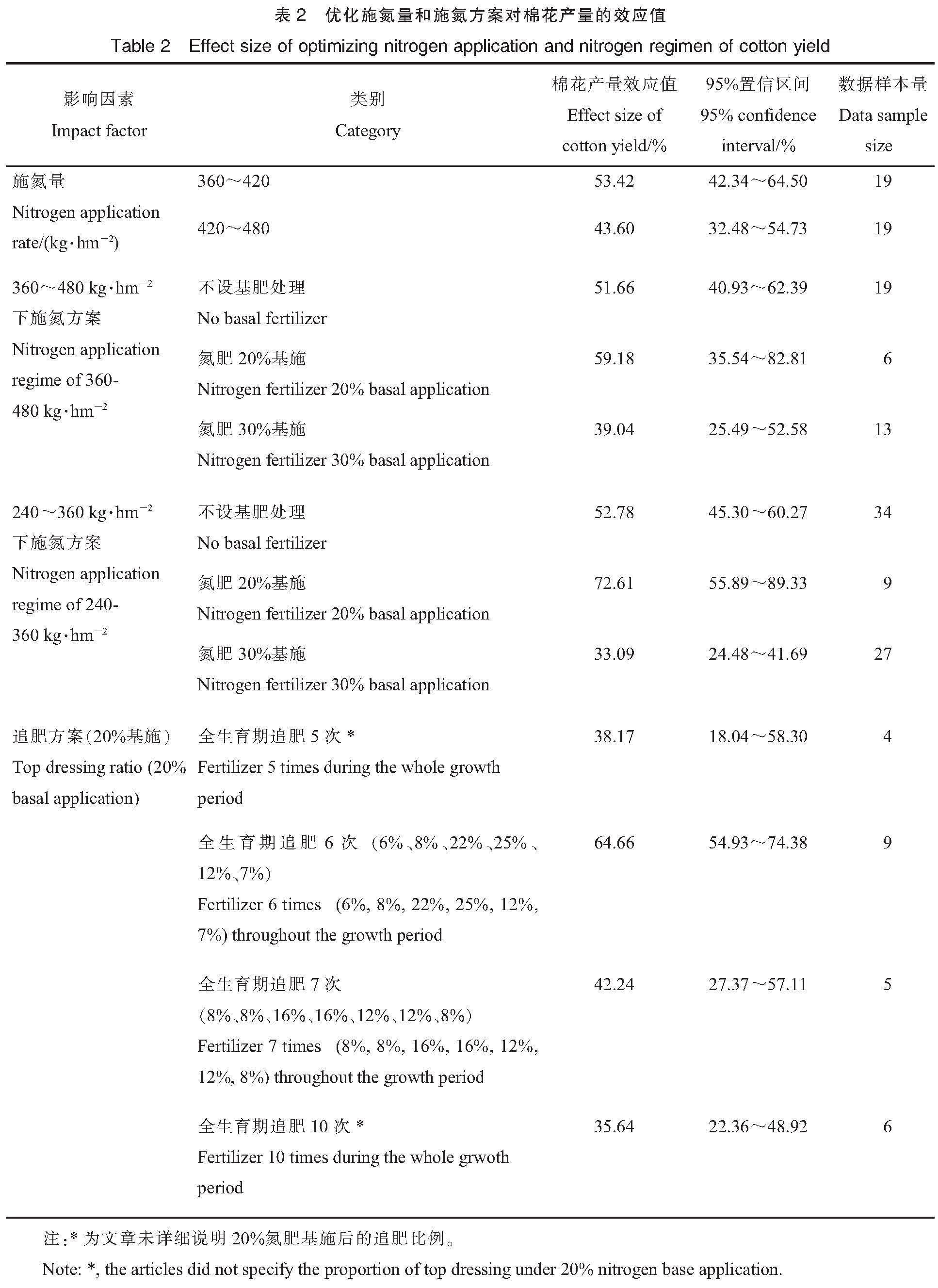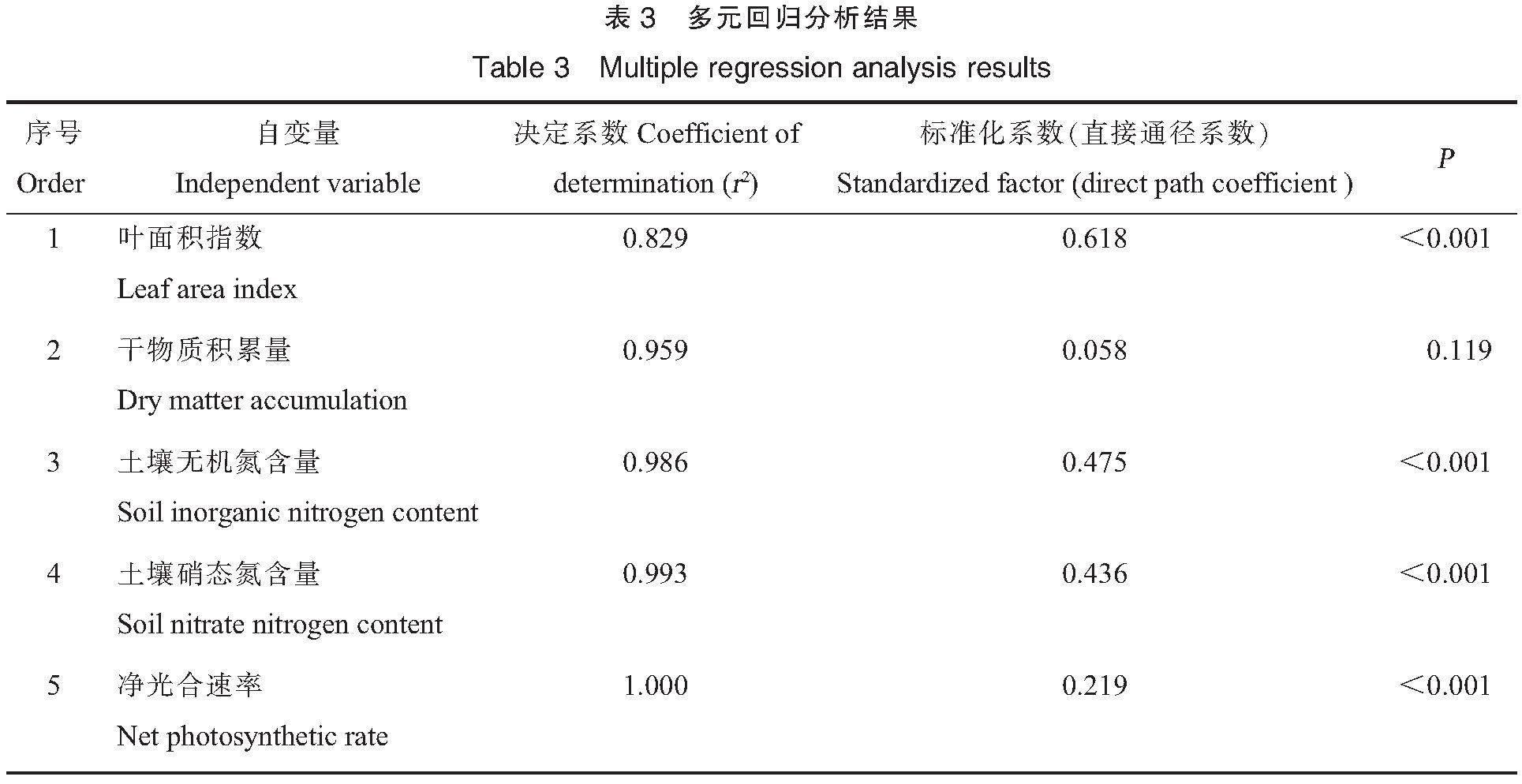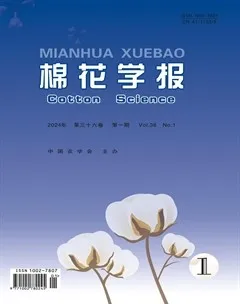基于元分析的新疆膜下滴灌棉田精量施氮研究
許琪 宋在金 李朝陽 董曉梅 黃童童 宋戰(zhàn) 肖飛 楊玉輝



摘要:【目的】明確施氮對棉花產量及其構成因子的影響,并為氮肥的精量施用及棉花高產提供理論借鑒。【方法】以新疆膜下滴灌棉田為研究對象,采用元分析(meta-analysis,meta分析)和通徑分析,研究不同施氮量、施氮方案、氣候條件等對棉花產量的綜合效應及影響機制。【結果】與不施氮相比,施氮能顯著提高棉花產量,增產效應為43.38%。施氮量為360~480 kg·hm-2時,對棉花的增產效應最大;施氮量超過此范圍,棉花產量不再顯著增加,本研究推薦的經濟施氮量為360~420 kg·hm-2。基肥20%,追肥80%且按照6%、8%、22%、25%、12%、7%的比例隨水滴施6次的施氮方案對棉花的增產效應最大。對于年蒸發(fā)量>2 000 mm、年降水量<60 mm、年日照時間<2 864 h、年有效積溫>4 000 ℃、無霜期>200 d的地區(qū),且土壤為砂質土、土壤初始有機碳含量<5.8 g·kg-1、初始速效氮含量≤60 mg·kg-1的棉田,施氮的增產效應最明顯。通徑分析結果表明,施氮通過提高土壤硝態(tài)氮含量,從而增加棉花葉面積指數,對棉花產量的提升貢獻最顯著。【結論】建議新疆植棉區(qū)施氮量為360~420 kg·hm-2,采用上述優(yōu)化方案合理施氮,可以實現膜下滴灌棉田的高產并降低環(huán)境風險。
關鍵詞:精量施氮;施氮方案;膜下滴灌;棉花產量;元分析;通徑分析
A study on precise nitrogen fertilization in drip irrigation cotton field under film in Xinjiang based on meta-analysis
Abstract: [Objective] The effect of nitrogen application on cotton yield and its constituent factors is clarified, aiming to provide theoretical reference for the precise application of nitrogen fertilizer and high cotton yield. [Methods] The comprehensive effects and influencing mechanisms of different nitrogen application rates, nitrogen application schemes, and climatic conditions on cotton yield are studied by meta-analysis and path analysis in Xinjiang. [Results] Compared with no nitrogen application, nitrogen application could significantly increase cotton yield with 43.38%. Nitrogen application of 360-480 kg·hm-2 had the greatest effect on cotton yield. Nitrogen application exceeding this range no longer increased cotton yield significantly, and the recommended economic nitrogen application rate in this study was 360-420 kg·hm-2. The nitrogen application scheme of 20% of basic fertilizer, 80% of supplementary fertilizer and 6 times of drip application with water at the rate of 6%, 8%, 22%, 25%, 12%, and 7% had the greatest effect on cotton yield. The greatest yield increase was achieved by the nitrogen fertilization program. The most obvious effect of nitrogen application was found in cotton fields with annual evaporation >2 000 mm, annual precipitation <60 mm, annual sunshine time <2 864 h, annual effective cumulative temperature >4 000 ℃, and frost-free period >200 d, and in fields with sandy soil, initial soil organic carbon content <5.8 g·kg-1, and initial soil available nitrogen content ≤60 mg·kg-1 . The results of the pathway analysis showed that nitrogen application contributed most significantly to the enhancement of cotton yield by increasing the soil nitrate nitrogen content, thereby increasing the cotton leaf area index. [Conclusion] It is suggested that nitrogen application rate of 360 - 420 kg·hm-2 with the above optimization scheme should be used in Xinjiang cotton area to achieve high cotton yield and reduce environmental risk in drip irrigation cotton fields under film.
Keywords: precise nitrogen application; nitrogen application scheme; drip irrigation cotton under film; cotton yield; meta-analysis;? path analysis
棉花是世界上重要的經濟作物,在世界農業(yè)發(fā)展中占據重要地位[1]。中國的棉花種植主要分布在長江流域、黃河流域以及西北內陸地區(qū)。近年來,隨著長江流域和黃河流域棉花種植面積的減少,新疆已成為我國最大的植棉區(qū)[2],新疆棉花產量約占全國總產量的90.2%[3]。棉花膜下滴灌是將滴灌技術和覆膜技術相結合,保證棉花生長適宜的水熱環(huán)境,使棉花生育期提前,顯著提高棉花產量[4]。肥料的投入是保證棉花高產的重要手段,不合理的氮肥施用導致氮素流失加劇、環(huán)境負擔加重,不利于棉花的生長和產量形成[5]。精量施氮就是在經濟的基礎上采取最優(yōu)的施氮方案實現棉花的高質高產,同時減少溫室效應和地下水污染等環(huán)境問題,精量施氮作為精準農業(yè)的核心在可持續(xù)發(fā)展中發(fā)揮重要作用[6]。因此,研究精量施氮對棉花產量的影響及其關鍵作用因子對實現棉花高產具有重要意義。
施氮量對膜下滴灌棉花產量的影響已有眾多研究,但由于種植地點和評價方法的多樣性導致研究結論不一。在新疆阿瓦提縣試驗站的研究表明,當施氮量為0~220 kg·hm-2時,隨著施氮量的增加,棉花對氮素養(yǎng)分的吸收量和產量顯著增加[7]。在塔里木大學農學試驗站的研究表明,施氮量為317~395 kg·hm-2時,棉花的氮素累積量隨施氮量的增加而顯著增加;根據皮棉產量與施氮量的二次方程計算發(fā)現皮棉產量最高的施氮量為361.2 kg·hm-2 [8];在石河子大學農學院試驗站的研究表明,施氮能顯著提高作物對氮素的吸收積累,棉花的合理施氮量為360 kg·hm-2 [9]。周燕等[10]通過元分析(meta-analysis,meta分析)方法評價了棉花產量和氮素吸收量對施氮的響應,但未對棉花的施氮方案及其他影響因素進行深入挖掘。眾多研究中對于適宜施氮量的結論不一,為了探明施氮量對土壤理化特性、棉花生長及產量的影響,需要1種綜合的分析方法對已有研究進行深度挖掘,以得到更加科學、準確且適用性強的結論。
獨立的田間試驗難以準確評價施氮對棉花產量的綜合效應,且關于深入挖掘棉花產量影響因素的研究還鮮有報道。本研究以新疆膜下滴灌棉田為研究對象,基于meta分析方法,系統(tǒng)研究施氮量對膜下滴灌棉田土壤理化特性、棉花生理生長及產量的影響;利用線性回歸模型進行通徑分析,明確土壤氮素含量、棉花干物質積累量、氮素吸收量等指標對產量影響的相對重要性,確定適宜施氮量及施氮方案,為氮肥的精量施用及棉花高產提供理論借鑒。
1 材料與方法
1.1 數據來源
本研究采納的文獻數據來源于中國知網(www.cnki.net)和Web of Science(www.webofscience.com),在中國知網中采用主題詞高級檢索,文獻檢索關鍵詞為:“棉花”AND“膜下滴灌+滴灌”AND“棉花產量+產量”;在Web of Science中采用主題詞高級檢索,文獻檢索關鍵詞為:cotton + cotton yield + drip irrigation。排除咸水、微咸水、磁化水等灌水水質,篩選1960年1月1日-2022年12月31日學者發(fā)表的期刊論文及碩博士學位論文。根據研究主題的需要,文獻篩選納入需符合以下標準[11-15]:(1)試驗為新疆的田間試驗,盆栽及室內試驗不考慮在內,試驗對象為棉花。(2)試驗重復數≥3。(3)文獻中需包含不施氮處理作為對照。(4)研究案例中所記錄的棉花產量為籽棉產量。(5)相同處理下的多次重復觀測取平均值。(6)當試驗中有附加因子影響的研究,則認為是獨立的試驗單獨納入數據庫。(7)對于文獻中同一地區(qū)的多年試驗研究,認為是相互獨立的試驗單獨納入數據庫。文獻中的表格數據直接提取,柱狀圖和折線圖中的數據采用軟件Get Data 2.20將圖像數值化后再提取。按照以上標準,篩選得到41篇文獻和1 262組數據。
1.2 分組分析
由于氣候條件、土壤肥力、品種等對棉花產量的影響較大,同時施氮量和施氮方案等諸多因素均對棉花產量有影響。因此本研究對文獻數據進行分組:施氮量[16-18]、施氮方案、品種[7, 16, 19-24]、土壤質地[20, 25-27]、土壤速效氮含量[28]、土壤有機碳含量[28-29]、年降水量[30-31]、年蒸發(fā)量[32]、無霜期[33]、年有效積溫[32]和年日照時間[34],檢驗這些因素對棉花產量的影響(表1)。
1.3 數據分析
為了確保研究的可靠性,本研究以權重響應比(response ratio, RR)為統(tǒng)計學指標,以權重響應比的自然對數(lnRR)表示某一驅動因子的影響程度,計算公式如下[35]:
整合分析每個研究的權重響應比進行加權,得出平均加權響應(weighted response ratio, RR++)。另外,方差(variance, V)、權重系數(weighted factor, W)、RR++標準差和95%的置信區(qū)間(confidence interval, CI)通過以下公式計算獲得。
公式(3)中,m為分組數,例如不同土壤類型或不同施肥量的分組數,ki代表第i個分組的數據對數。公式(4)中,SDe2和SDc2代表施氮試驗組和不施氮對照組的標準差,對于文獻中缺失的SD值,以平均值的1/10進行代替;Ne和Nc代表試驗組和對照組的樣本數[37]。為了更好地理解meta分析的結果,95%CI通過(eRR++-1)×100%轉化為變化百分數,當95%CI遠離零線時,表明處理組的研究指標與對照組有顯著差異(P<0.05);當95%CI與零線交集時,表明處理組的研究指標與對照組沒有顯著差異(P≥0.05)。
本研究利用線性回歸模型,以棉花產量為因變量,以數據庫中的土壤無機氮含量、土壤硝態(tài)氮含量、土壤銨態(tài)氮含量、干物質積累量、氮素吸收量、葉面積指數、凈光合速率和株高等數據為自變量,按照meta分析中施氮量的不同亞組將上述指標進行分組開展通徑分析,發(fā)掘實現棉花高產的關鍵影響因素[38]。對于上述指標存在一項研究中不同時期(苗期、蕾期、花鈴期等)的多個觀測值,本研究在多元回歸分析中將每一項研究的不同觀測值進行平均值處理。首先,利用逐步回歸法對上述自變量與因變量(棉花產量)進行多元線性回歸分析[39]。為了全面概括影響產量的關鍵因素,本研究將P<0.1(顯著)的指標全部納入進行分析。通徑分析中間接通徑系數計算公式[40]為:
Pij=rij×Pjy(8)
式中,Pij為間接通徑系數(自變量i通過自變量j作用于因變量y),rij為i與j的相關系數,Pjy為j與因變量y的標準化系數(通徑系數)。
對數據進行卡方檢驗,明確各研究之間是否存在明確的異質性。若P>0.05,說明各研究結果無明顯差異,采用固定效應模型進行計算;否則采用隨機效應模型進行計算。采用失安全系數法(fail-safe number,Nfs)進行偏倚性檢驗,若Nfs>5n+10,n為數據對數,則說明不存在發(fā)表偏倚,結論可信[41]。
1.4 統(tǒng)計分析
采用Microsoft Office 2016辦公軟件完成數據庫的建立以及部分數據的計算;使用MetaWin 2.1采用隨機效應模型的meta分析;使用GraphPad Prism 8和Origin 2021完成圖形繪制;使用IBM SPSS Statistics 27進行線性回歸分析。
2 結果與分析
2.1 施氮對棉田土壤、棉花生理生長及產量的效應分析
由圖1可知,本研究數據的異質性檢驗結果顯示,P值均小于0.05,說明不同研究之間存在異質性,故采用隨機效應模型進行分析。圖1中各指標失安全系數均大于5n+10,圖2中棉花產量效應值的頻數分布基本服從正態(tài)分布,說明本研究結果受發(fā)表偏倚的影響較小,結論可信。
如圖1所示,與不施氮相比,施氮能顯著增加土壤無機氮含量、土壤硝態(tài)氮含量和土壤銨態(tài)氮含量,效應值分別為43.80%(95%CI:34.66%~52.93%)、72.18%(95%CI:65.36%~79.00%)、10.72%(95%CI:0.39%~21.05%)。與不施氮相比,施氮能顯著增加棉花干物質積累量、氮素吸收量、葉面積指數、凈光合速率和株高,效應值分別為27.26%(95%CI:23.54%~30.99%)、51.68%(95%CI:47.33%~56.03%)、28.78%(95%CI:26.32%~31.25%)、16.65%(95%CI:14.00%~19.30%)和17.73%(95%CI:14.97%~20.49%)。與不施氮相比,施氮能顯著增加棉花單株鈴數和產量,效應值分別為27.45%(95%CI:23.95%~30.95%)和43.38%(95%CI:40.44%~46.33%)。綜上所述,施氮對棉田土壤氮素含量、棉花生理生長及產量等指標均有顯著促進效果。
2.2 棉花產量對施氮的響應及因素分析
不同施氮量對棉花增產的效應存在差異。施氮量為360~480 kg·hm-2時,施氮的效應值(48.54%,95%CI:41.50%~55.57%)高于施氮量為0~240 kg·hm-2的效應值(39.38%,95%CI:34.14%~44.62%)和施氮量為240~360 kg·hm-2的效應值(47.56%,95%CI:42.57%~52.56%);進一步增加施氮量(超過480 kg·hm-2),施氮對棉花增產的效應值反而降低(圖3)。因此,施氮量為360~480 kg·hm-2的增產效應最明顯。
對于不同棉花品種,施氮的增產效果也存在差異(圖3)。施氮對新陸中26號的增產效應(81.83%,95%CI:63.83%~99.83%)高于其對中棉所49(77.82%,95%CI:63.38%~92.26%)、新陸中66號(64.66%,95%CI:50.57%~78.74%)和新陸早45號(43.00%,95%CI:30.79%~55.20%)的增產效應,而施氮對新陸早50號、新陸早84號、新陸中65號和新陸中88號的產量效應相對較小,分別為24.51%、23.68%、21.45%和12.51%。綜合來看,施氮對新陸中26號的增產效應最明顯,但由于新陸中26號育成時間較早,根據國家農作物優(yōu)良品種推廣目錄(2023年)和中棉所49的品種特性[42-43],結合研究結果篩選出中熟棉品種中棉所49和新陸中66號適宜新疆中早熟棉區(qū)種植。
施氮對棉花產量的影響效果與土壤條件密切相關。施氮條件下,棉田為砂質土時增產效應最優(yōu),效應值為58.92%(95%CI:50.34%~67.50%),棉田為壤土和中壤土時增產效應相近,分別為33.31%(95%CI:28.81%~37.81%)和30.75%(95%CI:25.05%~36.45%)。隨著土壤初始有機碳含量的增加,施氮較不施氮處理對棉花產量的效應值降低,具體表現為:土壤有機碳含量≤5.8 g·kg-1時增產效應為53.30%(95%CI:47.29%~59.31%)、土壤有機碳含量為5.8~11.6 g·kg-1時增產效應為44.02%(95%CI:39.83%~48.22%)。隨著土壤初始速效氮含量的增加,施氮較不施氮處理對棉花產量的提升效應顯著降低,具體表現為:土壤速效氮含量≤60 mg·kg-1時增產效應為52.91%(95%CI:48.62%~57.21%),土壤速效氮含量為60~120 mg·kg-1時增產效應為38.41%(95%CI:33.37%~43.46%)。因此,在土壤為砂質土、初始有機碳含量≤5.8 g·kg-1和初始速效氮含量≤60 mg·kg-1的棉田,施氮的增產效應最明顯(圖4)。
施氮對棉花產量的影響效果與氣候條件密切相關。隨著年蒸發(fā)量的增加,與不施氮相比,施氮對棉花產量的提升效應呈顯著增加趨勢,具體表現為:年蒸發(fā)量為1 500~2 000 mm時,施氮的產量效應值為39.16%(95%CI:35.41%~42.91%);年蒸發(fā)量≥2 000 mm時,施氮的產量效應值為71.90%(95%CI:64.59%~79.20%)。隨著年降水量的增加,與不施氮相比,施氮對棉花產量的提升效應呈顯著降低的趨勢,具體表現為:年降水量<60 mm時,施氮的產量效應值為53.66%(95%CI:47.11%~60.21%),年降水量為60~200 mm時,施氮的產量效應值為35.83%(95%CI:29.94%~41.72%)。隨著年平均日照時間的延長,與不施氮相比,施氮對棉花產量的提升效應呈顯著降低趨勢,具體表現為:年平均日照時間<2 864 h時,施氮的產量效應值為53.52%(95%CI:46.12%~60.93%);年平均日照時間≥2 864 h時,施氮的產量效應值為39.32%(95%CI:35.82%~42.82%)。隨著年有效積溫的增加,施氮對棉花產量的提升效應顯著增加,具體表現為:年有效積溫為3 000~4 000 ℃時,施氮的產量效應值為34.02%(95%CI:30.86%~37.18%);年有效積溫>4 000 ℃時,施氮的產量效應值為64.66%(95%CI:57.08%~72.24%)。隨著無霜期的增加,與不施氮相比,施氮對棉花產量的效應值略微增加,但差異不顯著,具體表現為:無霜期為150~200 d時,施氮的產量效應值為40.56%(95%CI:37.20%~43.92%);無霜期>200 d時,施氮的產量效應值為41.93%(95%CI:36.84%~47.02%)。因此,在年蒸發(fā)量>2 000 mm、年降水量<60 mm、年平均日照時間<2 864 h、年有效積溫>4 000 ℃、無霜期>200 d條件下,施氮的增產效應最明顯(圖5)。
2.3 膜下滴灌棉田施氮方案的優(yōu)化分析
由圖3可知,施氮量為360~480 kg·hm-2時,施氮對棉花產量的效應值最大;施氮量在240~360 kg·hm-2時對棉花增產的效應值與其相近,精量施氮要求將施氮量控制在1個較窄的范圍以實現最高產量[44-45]。因此本研究繼續(xù)優(yōu)化施氮量進行亞組分析(表2),施氮量360~420 kg·hm-2對棉花產量的效應值為53.42%(95%CI:42.34%~64.50%)大于施氮量420~480 kg·hm-2對棉花產量的效應值43.60%(95%CI:32.48%~54.73%)。因此,在施氮量360~480 kg·hm-2范圍內,最優(yōu)的施氮量為360~420 kg·hm-2。
施氮方案同樣影響棉花對氮肥的吸收利用,新疆植棉區(qū)的棉花施肥多以隨水滴施為主,對不同施氮方案進行亞組分析,結果表明,氮肥20%基施能夠有效提高棉花產量,棉花增產效應值為59.18%(95%CI:35.54%~82.81%),高于不設基肥和氮肥30%基施處理。用240~360 kg·hm-2施氮量的施氮方案進行亞組分析用于驗證[46],結果表明,氮肥20%基施處理能夠有效提高棉花產量,且棉花增產效應值比不設基肥和氮肥30%基施處理高。對不同追肥比例進行亞組分析,結果表明,棉花生育期追肥6次且每次追肥比例分別為6%、8%、22%、25%、12%、7%對棉花產量的效應值最大。綜合來看,氮肥20%基施,其余80%分6次按6%、8%、22%、25%、12%、7%的比例隨水滴施效果最好。
2.4 施氮對棉花產量影響因素的通徑分析
眾多研究中對于棉花產量的影響因素結論不一,多數研究僅探討了施氮對棉花產量及個別指標的影響[27, 47],未對棉花產量的影響因素進行深度挖掘與全面概括。本研究采用線性回歸模型開展通徑分析,探究棉花高產的關鍵影響因素,通徑分析結果如表3所示,對棉花產量影響顯著的指標分別為葉面積指數、干物質積累量、土壤無機氮含量、土壤硝態(tài)氮含量和凈光合速率。計算過程中逐步引入葉面積指數、干物質積累量、土壤無機氮含量、土壤硝態(tài)氮含量和凈光合速率,回歸方程決定系數r2為1.000,說明回歸擬合效果較好,對棉花產量有影響的自變量引入較為完善。比較直接通徑系數可知,葉面積指數對棉花產量的直接影響最大,干物質積累量對產量的直接影響最小。
為深入探討施氮對棉花產量的影響途徑,按照“施氮通過提高土壤氮素含量,從而促進棉花生理生長進而提高棉花產量”的邏輯,利用公式(8)計算土壤氮素指標與棉花生理生長指標的間接通徑系數。計算結果如表4所示,施氮通過提高土壤硝態(tài)氮含量,從而增加棉花葉面積指數,對棉花產量的提升貢獻最顯著。
3 討論
氮素對于作物產量的形成具有關鍵作用,合理施用氮肥是作物高產的重要措施[48-49]。施氮能促進土壤無機氮含量的增加,土壤銨態(tài)氮和土壤硝態(tài)氮作為良好氮源是棉花吸收利用的主要無機氮[50],氮素是促進植株生長發(fā)育最重要的營養(yǎng)元素。因此,增施氮肥能顯著促進棉花生長并提高鈴數和產量[51-52]。
精量施肥強調應根據不同類型的土壤、天氣條件等因素,采用不同的施肥方法和施肥制度及施用量[53]。施氮在砂質土棉田的增產效果最優(yōu)、黏土質地棉田次之。砂質土壤具有透氣性能好、透水性強的優(yōu)點,在砂質土壤中施氮能顯著改善土壤環(huán)境[54],提高作物產量;黏土保肥性能強,能夠對養(yǎng)分進行吸附固定,這可能是黏土增產高效的原因。不同的土壤初始肥力對棉花產量影響顯著,土壤初始肥力過高會導致土壤中微生物活動旺盛,進而消耗土壤氧氣,降低棉花產量,本研究表明在土壤初始有機碳含量≤5.8 g·kg-1、初始速效氮含量≤60 mg·kg-1時增產效應最明顯。新疆植棉區(qū)氣候為典型的溫帶大陸性干旱氣候,降水少、蒸發(fā)量大,棉花具有較強的耐旱性。較高的氣溫環(huán)境有利于棉花的生長,低溫會延長棉花生育期導致產量下降[55]。光照在棉花生長階段具有重要作用,充足的光照有利于作物的光合作用、增加光合產物從而促進作物生長[56],在降水量適宜的情況下,施氮能顯著提高棉花產量;降水過多會導致土壤氮素淋失、土壤水分蒸發(fā)增加。這均與本研究結論一致,本研究結果表明,在年蒸發(fā)量>2 000 mm、年降水量<60 mm、年平均日照時間<2 864 h、年有效積溫>4 000 ℃和無霜期>200 d的情況下,施氮的增產效應最明顯。
本研究結果表明,施氮量為360~480 kg·hm-2時,施氮對棉花增產的效應值最大,超過此范圍棉花產量不再顯著增加,本研究推薦的經濟施氮量為360~420 kg·hm-2。徐海江等[18]在南疆阿瓦提縣的研究表明,過量施氮不利于提高棉花產量,當施氮量超過450 kg·hm-2時棉花產量不再顯著增加,經氮肥效應方程計算出最高產量下的施氮量為427.832 kg·hm-2。李志強等[57]在北疆石河子進行的研究表明,施氮過量或者過低均難以獲得高產,施氮量為360 kg·hm-2時,棉花產量最高;而施氮量超過392 kg·hm-2時,棉花產量顯著降低。由此可見,本研究提出的經濟施氮量適于新疆植棉區(qū)的棉花種植。新疆植棉區(qū)土壤普遍存在貧瘠化的現象。不合理的施氮方案不但會降低肥效,而且會造成嚴重的經濟損失和環(huán)境污染[58]。對于膜下滴灌棉田,部分試驗不設基肥處理,在棉花生長期間將氮肥隨水滴施[7, 20];部分試驗將20%或30%氮肥作基肥[16, 22]。適當基肥處理能夠為棉花前期生長發(fā)育提供適宜的土壤肥力條件,也有改良土壤、培肥地力的作用。基肥缺乏會影響作物根系生長,導致植株發(fā)育后期營養(yǎng)不良,造成減產。基肥過量會導致植株營養(yǎng)失衡,抑制棉花生長,棉花也更容易發(fā)生病蟲害。這可能是本研究中20%氮肥作基肥的增產效應優(yōu)于無基肥處理和30%氮肥作基肥的原因。有研究表明,與低施肥頻次(不大于5次)相比,高施肥頻次(5次以上)更能充分發(fā)揮肥效,顯著提高棉花產量[54]。這與本研究結論一致,本研究精量施氮方案為全生育期施氮360~420 kg·hm-2,且20%作基肥處理,剩余80%分6次作追肥處理,每次施用比例為6%、8%、22%、25%、12%和7%,在新疆植棉區(qū)根據施氮方案精量施氮是實現棉花高產的重要措施。
棉田土壤無機氮含量代表著土壤氮素水平,施用氮肥是無機氮積累的前提[59-60],而硝態(tài)氮作為無機氮的主要存在形式是棉花吸收利用的主要氮素形態(tài)。葉片作為棉花進行光合作用的主要器官,與產量的形成有著密不可分的關系[61],葉面積指數一定程度上能反映植株的生長發(fā)育情況。有研究表明在棉花快速生長時期,葉面積指數升高較快,干物質積累總量較高[62]。干物質積累是棉花產量的物質基礎、增施氮肥會促進棉花的干物質積累和對氮素的吸收[63-64]。由此可見,葉面積指數對棉花產量構成有顯著影響。通徑分析結果表明,葉面積指數對棉花產量影響較大,施氮通過提高棉田土壤硝態(tài)氮含量,從而增加棉花葉面積指數,對棉花產量的提升貢獻最大。
4 結論
本研究深入分析了施氮對棉花產量的綜合效應及影響機制,通過元分析和通徑分析研究表明,與不施氮相比,施氮能顯著提高棉花產量,增產效應為43.38%;施氮量為360~480 kg·hm-2時增產效應最高,超過此用量,施氮對棉花產量的效應值反而降低,本研究推薦的經濟施氮量為360~420 kg·hm-2。施氮方案為基肥20%,追肥80%且按照6%、8%、22%、25%、12%、7%的比例隨水滴施6次。對于年蒸發(fā)量>2 000 mm、年降水量<60 mm、年日照時間<2 864 h、年有效積溫>4 000 ℃、無霜期>200 d的地區(qū),且土壤為砂質土質地、土壤初始有機碳含量<5.8 g·kg-1、土壤初始速效氮含量≤60 mg·kg-1的棉田,施氮增產效應最明顯。棉花葉面積指數對棉花產量的直接影響較大,施氮通過提高棉田土壤硝態(tài)氮含量,從而增加植株葉面積指數,對棉花產量的提升貢獻最顯著。
參考文獻:
[1] Tan Hong, Ma Qiong. A tentative discussion on the constraints on production and development of cotton and countermeasures[C/OL]//2017 International Conference on Frontiers in Educational Technologies and Management Sciences(FETMS 2017). Nanjing: [s. n.]. 2017: 280-283[2023-11-01]. https://doi.org/10.25236/fetms.2017.066.
[2] Yang Z, Tang J, Yu M, et al. Sustainable cotton production through increased competitiveness: analysis of comparative advantage and influencing factors of cotton production in Xinjiang, China[J/OL]. Agronomy, 2022, 12(10): 2239[2023-11-01]. https://doi.org/10.3390/agronomy12102239.
[3] 國家統(tǒng)計局關于2022年棉花產量的公告[N/OL]. 中國信息報, 2022-12-27(001)[2023-11-01]. https://doi.org/10.38309/n.cnki.nzgxx.2022.001214.
Announcement of national bureau of statistics on cotton production in 2022[N/OL]. China Information News, 2022-12-27(001)[2023-11-01]. https://doi.org/10.38309/n.cnki.nzgxx.2022.001214.
[4] 徐飛鵬, 李云開, 任樹梅. 新疆棉花膜下滴灌技術的應用與發(fā)展的思考[J]. 農業(yè)工程學報, 2003, 19(1): 25-27.
Xu Feipeng, Li Yunkai, Ren Shumei. Investigation and discussion of drip irrigation under mulch in Xinjiang Uygur Autonomous Region[J]. Transactions of the Chinese Society of Agricultural Engineering, 2003, 19(1): 25-27.
[5] 孫志梅, 武志杰, 陳利軍, 等. 農業(yè)生產中的氮肥施用現狀及其環(huán)境效應研究進展[J/OL]. 土壤通報, 2006, 37(4): 782-786[2023-11-01]. https://doi.org/10.3321/j.issn:0564-3945.2006.04.037.
Sun Zhimei, Wu Zhijie, Chen Lijun, et al. Research advances in nitrogen fertilization and its environmental effects[J/OL]. Chinese Journal of Soil Science, 2006, 37(4): 782-786[2023-11-01]. https://doi.org/10.3321/j.issn:0564-3945.2006.04.037.
[6] Chen C, Pan J, Lam S K. A review of precision fertilization research[J/OL]. Environmental Earth Sciences, 2014, 71: 4073-4080[2023-11-01]. https://doi.org/10.1007/s12665-013-2792-2.
[7] 張宏, 曾雄, 王愛蓮, 等. 不同施氮量對棉花產量、養(yǎng)分吸收及氮素利用的影響[J/OL]. 新疆農業(yè)科學, 2021, 58(9): 1656-1664[2023-11-01]. https://doi.org/10.6048/j.issn.1001-4330.2021.09.011.
Zhang Hong, Zeng Xiong, Wang Ailian, et al. Effects of different nitrogen application rates on yield, nutrient uptake and nitrogen utilization of cotton in southern Xinjiang[J/OL]. Xinjiang Agricultural Sciences, 2021, 58(9): 1656-1664[2023-11-01]. https://doi.org/10.6048/j.issn.1001-4330.2021.09.011.
[8] 杜夢旗, 盧銳, 張哲, 等. 不同施氮量對滴灌棉田氮素利用率的影響[J/OL]. 農業(yè)與技術, 2022, 42(4): 10-13[2023-11-01]. https://doi.org/10.19754/j.nyyjs.20220228103.
Du Mengqi, Lu Rui, Zhang Zhe, et al. Effect of different nitrogen application rates on nitrogen utilisation in drip-irrigated cotton fields[J/OL]. Agriculture & Technology, 2022, 42(4): 10-13[2023-11-01]. https://doi.org/10.19754/j.nyyjs.20220228103.
[9] 王肖娟, 危常州, 張君, 等. 灌溉方式和施氮量對棉田氮肥利用率及損失的影響[J/OL]. 應用生態(tài)學報, 2012, 23(10): 2751-2758[2023-11-01]. https://doi.org/10.13287/j.1001-9332.2012.0379.
Wang Xiaojuan, Wei Changzhou, Zhang Jun, et al. Effects of irrigation mode and N application rate on cotton field fertilizer N use efficiency and N losses[J/OL]. Chinese Journal of Applied Ecology, 2012, 23(10): 2751-2758[2023-11-01]. https://doi.org/10.13287/j.1001-9332.2012.0379.
[10] 周燕, 孫洋洋, 胡志偉, 等. 氮肥對棉花產量和氮素吸收量影響的Meta分析[J/OL]. 福建農業(yè)學報, 2022, 37(3): 317-325[2023-11-01]. https://doi.org/10.19303/j.issn.1008-0384.2022.003.006.
Zhou Yan, Sun Yangyang, Hu Zhiwei, et al. Meta analysis on effects of N-fertilization on yield and N-uptake of cotton plants[J/OL]. Fujian Journal of Agricultural Sciences, 2022, 37(3): 317-325[2023-11-01]. https://doi.org/10.19303/j.issn.1008-0384.2022.003.006.
[11] Ainsworth E A. Rice production in a changing climate: a metaanalysis of responses to elevated carbon dioxide and elevated ozone concentration[J/OL]. Global Change Biology, 2008, 14(7): 1642-1650[2023-11-01]. https://doi.org/10.1111/j.1365-2486.2008.01594.x.
[12] Feng Z, Shang B, Gao F, et al. Current ambient and elevated ozone effects on poplar: a global meta-analysis and response relationships[J/OL]. Science of the Total Environment, 2019, 654: 832-840[2023-11-01]. https://doi.org/10.1016/j.scitotenv.2018.11.179.
[13] de Graaff M A, van Groenigen K J, Six J, et al. Interactions between plant growth and soil nutrient cycling under elevated CO2: a meta-analysis[J/OL]. Global Change Biology, 2006, 12(11): 2077-2091[2023-11-01]. https://doi.org/10.1111/j.1365-2486.2006.01240.x.
[14] Liao C Z, Peng R H, Luo Y Q, et al. Altered ecosystem carbon and nitrogen cycles by plant invasion: a meta-analysis[J/OL]. New Phytologist, 2008, 177(3): 706-714[2023-11-01]. https://doi.org/10.1111/j.1469-8137.2007.02290.x.
[15] Treseder K K. A meta-analysis of mycorrhizal responses to nitrogen, phosphorus, and atmospheric CO2 in field studies[J/OL]. New Phytologist, 2004, 164(2): 347-355[2023-11-01]. https://doi.org/10.1111/j.1469-8137.2004.01159.x.
[16] 張澤, 馬革新, 海興巖, 等. 氮肥和土壤質地對滴灌棉花根系分布及產量的影響[J/OL]. 土壤, 2018, 50(3): 622-627[2023-11-01]. https://doi.org/10.13758/j.cnki.tr.2018.03.025.
Zhang Ze, Ma Gexin, Hai Xingyan, et al. Effect of nitrogen fertilization and soil texture on cotton root traits and yields under conventional drip irrigation[J/OL]. Soils, 2018, 50(3): 622-627[2023-11-01]. https://doi.org/10.13758/j.cnki.tr.2018.03.025.
[17] 董鵬. 棉花膜下滴灌氮素養(yǎng)分綜合管理技術研究[D]. 石河子: 石河子大學, 2011.
Dong Peng. Research on integrated management technology of nitrogen and nutrients in cotton under membrane drip irrigation[D]. Shihezi: Shihezi University, 2011.
[18] 徐海江, 田立文, 林濤, 等. 施氮量對南疆膜下滴灌陸地棉干物質積累與分配的影響[J]. 新疆農業(yè)科學, 2012, 49(10): 1765-1772.
Xu Haijiang, Tian Liwen, Lin Tao, et al. Study on effect of dry matter accumulation and distribute on the nitrogen fertilizer applied to upland cotton using drip irrigation under plastic film in southern Xinjiang[J]. Xinjiang Agricultural Sciences, 2012, 49(10): 1765-1772.
[19] 楊媚, 呂新, 馬露露, 等. 施氮量對不同品種滴灌棉花氮素利用率及產量的影響[J/OL]. 新疆農業(yè)科學, 2019, 56(7): 1223-1231[2023-11-01]. https://doi.org/10.6048/j.issn.1001-4330.2019.07.006.
Yang Mei, Lü Xin, Ma Lulu, et al. Effects of nitrogen application rate on nitrogen utilization efficiency and yield of different varieties of drip irrigation cotton (Gossypium hirsutum L.)[J/OL]. Xinjiang Agricultural Sciences, 2019, 56(7): 1223-1231[2023-11-01]. https://doi.org/10.6048/j.issn.1001-4330.2019.07.006.
[20] 廖歡, 甘浩天, 劉凱, 等. 機采棉氮素吸收及產量的最佳水氮組合[J/OL]. 植物營養(yǎng)與肥料學報, 2021, 27(12): 2229-2242[2023-11-01]. https://doi.org/10.11674/zwyf.2021180.
Liao Huan, Gan Haotian, Liu Kai, et al. Optimal water scheme and N rate for high N uptake and yield of machine-harvested cotton[J/OL]. Plant Nutrition and Fertilizer Science, 2021, 27(12): 2229-2242[2023-11-01]. https://doi.org/10.11674/zwyf.2021180.
[21] 鄧忠, 白丹, 翟國亮, 等. 膜下滴灌水氮調控對南疆棉花產量及水氮利用率的影響[J/OL]. 應用生態(tài)學報, 2013, 24(9): 2525-2532[2023-11-01]. https://doi.org/10.13287/j.1001-9332.2013.0500.
Deng Zhong, Bai Dan, Zhai Guoliang, et al. Effects of water and nitrogen regulation on the yield and water and nitrogen use efficiency of cotton in south Xinjiang, Northwest China under plastic mulched drip irrigation[J/OL]. Chinese Journal of Applied Ecology, 2013, 24(9): 2525-2532[2023-11-01]. https://doi.org/10.13287/j.1001-9332.2013.0500.
[22] 林濤, 郭仁松, 崔建平, 等. 施氮對南疆荒漠綠洲滴灌棉田產量及棉纖維品質的影響[J/OL]. 西北農業(yè)學報, 2013, 22(11): 47-53[2023-11-01]. https://doi.org/10.7606/j.issn.1004-1389.2013.11.009.
Lin Tao, Guo Rensong, Cui Jianping, et al. Effects of nitrogen application on cotton yield and fiber quality under drip irrigation condition in oasis of south Xinjiang[J/OL]. Acta Agriculturae Boreali-occidentalis Sinica, 2013, 22(11): 47-53[2023-11-01]. https://doi.org/10.7606/j.issn.1004-1389.2013.11.009.
[23] 爾晨. 水氮耦合對機采棉根冠特性及水氮利用的影響[D]. 烏魯木齊: 新疆農業(yè)大學, 2020.
Er Chen. Effects of water-nitrogen coupling on root-crown characteristics and water-nitrogen utilization of machine-picked cotton[D]. Urumqi: Xinjiang Agricultural University, 2020.
[24] 蒲勝海, 王則玉, 丁峰, 等. 膜下滴灌水氮空間調控對機采棉群體塑造及產量的影響[J/OL]. 新疆農業(yè)科學, 2022, 59(8): 1838-1846[2023-11-01]. https://doi.org/10.6048/j.issn.1001-4330.2022.08.003.
Pu Shenghai, Wang Zeyu, Ding Feng, et al. Machine-picked cotton population shaping and yield under mulch drip irrigation with different spatial distribution of water and nitrogen[J/OL]. Xinjiang Agricultural Sciences, 2022, 59(8): 1838-1846[2023-11-01]. https://doi.org/10.6048/j.issn.1001-4330.2022.08.003.
[25] 孟艷, 沈亞文, 孟維偉, 等. 生物炭施用對農田土壤團聚體及有機碳影響的整合分析[J/OL]. 環(huán)境科學, 2023(12): 1-13[2023-11-01]. https://doi.org/10.13227/j.hjkx.202210300.
Meng Yan, Shen Yawen, Meng Weiwei, et al. Effect of biochar on agricultural soil aggregates and organic carbon: a metaanalysis[J/OL]. Environmental Science, 2023(12): 1-13[2023-11-01]. https://doi.org/10.13227/j.hjkx.202210300.
[26] 王曉嬌, 張仁陟, 齊鵬, 等. Meta分析有機肥施用對中國北方農田土壤CO2排放的影響[J/OL]. 農業(yè)工程學報, 2019, 35(10): 99-107[2023-11-01]. https://doi.org/10.11975/j.issn.1002-6819.2019.10.013.
Wang Xiaojiao, Zhang Renzhi, Qi Peng, et al. Meta-analysis on farmland soil CO2 emission in northern China affected by organic fertilizer[J/OL]. Transactions of the Chinese Society of Agricultural Engineering, 2019, 35(10): 99-107[2023-11-01]. https://doi.org/10.11975/j.issn.1002-6819.2019.10.013.
[27] 郭金強, 危常州, 侯振安, 等. 施氮量對膜下滴灌棉花氮素吸收、積累及其產量的影響[J]. 干旱區(qū)資源與環(huán)境, 2008, 22(9): 139-142.
Guo Jinqiang, Wei Changzhou, Hou Zhenan, et al. Effect of N rates on N uptake, accumulation and yield of cotton under drip irrigation and mulch[J]. Journal of Arid Land Resources and Environment, 2008, 22(9): 139-142.
[28] 卞倩倩, 王雁楠, 陳金金, 等. 施鉀對我國甘薯產量和土壤鉀素平衡影響的Meta分析[J/OL]. 植物營養(yǎng)與肥料學報, 2022, 28(8): 1509-1519[2023-11-01]. https://doi.org/10.11674/zwyf.2021632.
Bian Qianqian, Wang Yannan, Chen Jinjin, et al. Effects of potassium application on yield and potassium balance of sweet potato field in China: a meta-analysis[J/OL]. Plant Nutrition and Fertilizer Science, 2022, 28(8): 1509-1519[2023-11-01]. https://doi.org/10.11674/zwyf.2021632.
[29] 呂春玲, 陳延華, 何文天, 等. 玉米種植體系土壤磷素有效性對有機肥長期施用響應的Meta分析[J/OL]. 農業(yè)環(huán)境科學學報, 2022, 41(9): 2011-2022[2023-11-01]. https://doi.org/10.11654/jaes.2022-0015.
Lü Chunling, Chen Yanhua, He Wentian, et al. Response of soil phosphorus availability to long-term application of organic fertilizer under maize cropping system: a meta-analysis[J/OL]. Journal of Agro-Environment Science, 2022, 41(9): 2011-2022[2023-11-01]. https://doi.org/10.11654/jaes.2022-0015.
[30] Wang Q, Zhai P M, Qin D H. New perspectives on 'warming-wetting' trend in Xinjiang, China[J/OL]. Advances in Climate Change Research, 2020, 11(3): 252-260[2023-11-01]. https://doi.org/10.1016/j.accre.2020.09.004.
[31] 中國科學院《中國自然地理》委員會. 中國自然地理: 氣候[M]. 北京: 科學出版社, 1984.
Committee on Physical Geography of China, Chinese Academy of Sciences. Physical geography of China: climate[M]. Beijing: Science Press, 1984.
[32] Gu X B, Cai H J, Fang H, et al. Effects of degradable film mulching on crop yield and water use efficiency in China: a meta-analysis[J/OL]. Soil and Tillage Research, 2020, 202: 104676[2023-11-01]. https://doi.org/10.1016/j.still.2020.104676.
[33] Qin Y, Chai Y, Li R, et al. Evaluation of straw and plastic film mulching on wheat production: a meta-analysis in loess plateau of China[J/OL]. Field Crops Research, 2022, 275: 108333[2023-11-01]. https://doi.org/10.1016/j.fcr.2021.108333.
[34] 宮園, 徐玉婷, 潘友菊,等. 氣候智慧型農業(yè)措施對中國農田土壤有機碳含量影響的Meta分析[J/OL]. 農業(yè)資源與環(huán)境學報, 2024, 41(1): 92-104[2023-11-01]. https://doi.org/10.13254/j.jare.2023.0152.
Gong Yuan, Xu Yuting, Pan Youju, et al. Effects of climate-smart agricultural measures on soil organic carbon content of farmland in China: a meta-analysis[J/OL]. Journal of Agricultural Resources and Environment, 2024, 41(1): 92-104[2023-11-01]. https://doi.org/10.13254/j.jare.2023.015.
[35] 趙鑫. 基于Meta-analysis對我國保護性耕作農田土壤固碳減排效應及其潛力的研究[D]. 北京: 中國農業(yè)大學, 2017.
Zhao Xin. Study on the effect of soil carbon sequestration and emission reduction and its potential of conservation tillage farmland in China based on meta-analysis[D]. Beijing: China Agricultural University, 2017.
[36] Dieleman W I J, Luyssaert S, Rey A, et al. Soil [N] modulates soil C cycling in CO2-fumigated tree stands: a meta-analysis[J/OL]. Plant, Cell & Environment, 2010, 33(12): 2001-2011[2023-11-01]. https://doi.org/10.1111/j.1365-3040.2010.02201.x.
[37] Chen H, Li X, Hu F, et al. Soil nitrous oxide emissions following crop residue addition: a meta-analysis[J/OL]. Global Change Biology, 2013, 19(10): 2956-2964[2023-11-01]. https://doi.org/10.1111/gcb.12274.
[38] 杜家菊, 陳志偉. 使用SPSS線性回歸實現通徑分析的方法[J/OL]. 生物學通報, 2010, 45(2): 4-6[2023-11-01]. https://doi.org/10.3969/j.issn.0006-3193.2010.02.002.
Du Jiaju, Chen Zhiwei. Method of path analysis with SPSS linear regression[J/OL]. Bulletin of Biology, 2010, 45(2): 4-6[2023-11-01]. https://doi.org/10.3969/j.issn.0006-3193.2010.02.002.
[39] Zhou L, Zhou X, Zhang B, et al. Different responses of soil respiration and its components to nitrogen addition among biomes: a meta-analysis[J/OL]. Global Change Biology, 2014, 20(7): 2332-2343[2023-11-01]. https://doi.org/10.1111/gcb.12490.
[40] 楊玉輝. 膜下滴灌鹽漬化棉田暗管排水技術參數研究[D]. 北京: 中國農業(yè)科學院, 2021.
Yang Yuhui. Study on technical paramerers of subsurface drainage in saline cotton field with drip irrigation under mulch[D]. Beijing: Chinese Academy of Agricultural Sciences, 2021.
[41] Yu L, Zhao X, Gao X, et al. Improving/maintaining water-use efficiency and yield of wheat by deficit irrigation: a global meta-analysis[J/OL]. Agricultural Water Management, 2020, 228: 105906[2023-11-01]. https://doi.org/10.1016/j.agwat.2019.105906.
[42] 中華人民共和國農業(yè)農村部. 國家農作物優(yōu)良品種推廣目錄(2023年)[EB/OL]. (2023-03-02)[2023-11-01]. http://www.zzj.moa.gov.cn/gzdt/202303/t20230302_6422033.htm.
Ministry of Agriculture and Rural Affairs of the Peoples Republic of China. National crop variety promotion Catalog (2023)[EB/OL]. (2023-03-02)[2023-12-20]. http://www.zzj.moa.gov.cn/gzdt/202303/t20230302_6422033.htm.
[43] 王寧, 黃群, 匡猛, 等. 新育種方法在中棉所49選育中的應用[J/OL]. 中國棉花, 2015, 42(4): 25-26, 28[2023-11-01]. http://doi.org/10.11963/issn.1000-632X.201504008.
Wang Ning, Huang Qun, Kuang Meng, et al. Application of a new breeding method in the breeding of CCRI 49[J/OL]. China Cotton, 2015, 42(4): 25-26, 28[2023-11-01]. http://doi.org/10.11963/issn.1000-632X.201504008.
[44] Ladha J K, Pathak H, Krupink T J, et al. Efficiency of fertilizer nitrogen in cereal production: retrospects and prospects[J/OL]. Advances in Agronomy, 2005, 87: 85-156[2023-11-01]. https://doi.org/10.1016/S0065-2113(05)87003-8.
[45] Peng S, Buresh R J, Huang J, et al. Improving nitrogen fertilization in rice by sitespecific N management. A review[J/OL]. Agronomy for Sustainable Development, 2010, 30: 649-656[2023-11-01]. https://doi.org/10.1051/agro/2010002.
[46] Wittig V E, Ainiworth E A, Naidu S L, et al. Quantifying the impact of current and future tropospheric ozone on tree biomass, growth, physiology and biochemistry: a quantitative meta-analysis[J/OL]. Global Change Biology, 2009, 15(2): 396-424[2023-11-01]. https://doi.org/10.1111/j.1365-2486.2008.01774.x.
[47] 胡明芳, 田長彥, 呂昭智, 等. 氮肥施用量對新疆棉花產量及植株和土壤中硝態(tài)氮含量的影響[J/OL]. 西北農林科技大學學報(自然科學版), 2006, 34(4): 63-68[2023-11-01]. https://doi.org/10.3321/j.issn:1671-9387.2006.04.015.
Hu Mingfang, Tian Changyan, Lü Zhaozhi, et al. Effects of N rate on cotton yield and nitrate-N concentration in plant tissue and soil[J/OL]. Journal of Northwest A&F University (Natural Science Edition), 2006, 34(4): 63-68[2023-11-01]. https://doi.org/10.3321/j.issn:1671-9387.2006.04.015.
[48] Tang S, Zhang H, Liu W, et al. Nitrogen fertilizer at heading stage effectively compensates for the deterioration of rice quality by affecting the starch-related properties under elevated temperatures[J/OL]. Food Chemistry, 2019, 277: 455-462[2023-11-01]. https://doi.org/10.1016/j.foodchem.2018.10.137.
[49] Xiong D, Yu T, Ling X, et al. Sufficient leaf transpiration and nonstructural carbohydrates are beneficial for high-temperature tolerance in three rice (Oryza sativa) cultivars and two nitrogen treatments[J/OL]. Functional Plant Biology, 2014, 42(4): 347-356[2023-11-01]. https://doi.org/10.1071/FP14166.
[50] Mokhele B, Zhan X, Yang G, et al. Nitrogen assimilation in crop plants and its affecting factors[J/OL]. Canadian Journal of Plant Science, 2012, 92(3): 399-405[2023-11-01]. https://doi.org/10.1139/CJPS2011-135.
[51] 孟妍君, 馬鑫穎, 宋晨, 等. 水氮調控對棉花生理性狀及產量的影響[J/OL]. 中國生態(tài)農業(yè)學報(中英文), 2023, 31(9): 1379-1391[2023-11-01]. https://doi.org/10.12357/cjea.20230002.
Meng Yanjun, Ma Xinying, Song Chen, et al. Effects of water and nitrogen regulation on physiological characteristics and yield of cotton[J/OL]. Chinese Journal of Eco-Agriculture, 2023, 31(9): 1379-1391[2023-11-01]. https://doi.org/10.12357/cjea.20230002.
[52] Dong H, Li W, Eneji A E, et al. Nitrogen rate and plant density effects on yield and late-season leaf senescence of cotton raised on a saline field[J/OL]. Field Crops Research, 2012, 126: 137-144[2023-11-01]. https://doi.org/10.1016/j.fcr.2011.10.005.
[53] Peng S, Garcia F V, Laza R C, et al. Increased N-use efficiency using a chlorophyll meter on high-yielding irrigated rice[J/OL]. Field Crops Research, 1996, 47(2/3): 243-252[2023-11-01]. https://doi.org/10.1016/0378-4290(96)00018-4.
[54] 蔡煥杰, 李府陽, 趙政鑫, 等. 施氮對中國棉田產量和水分利用效率影響的Meta分析[J]. 農業(yè)機械學報, 2023, 54(12): 316-326.
Cai Huanjie, Li Fuyang, Zhao Zhengxin, et al. A meta-analysis of the effects of nitrogen application on cotton yield and water use efficiency in China[J]. Transactions of the Chinese Society for Agricultural Machinery, 2023, 54(12): 316-326.
[55] 賈耀宇, 黃偉斌, 楊北方, 等. 虧缺灌溉對中國棉花產量和灌溉水分生產力影響的元分析[J/OL]. 棉花學報, 2023, 35(3): 195-210[2023-11-01]. https://doi.org/10.11963/cs20220065.
Jia Yaoyu, Huang Weibin, Yang Beifang, et al. A meta-analysis of yield and irrigation water productivity of cotton under deficit irrigation in China[J/OL]. Cotton Science, 2023, 35(3): 195-210[2023-11-01]. https://doi.org/10.11963/cs20220065.
[56] 王振華, 朱延凱, 張金珠, 等. 水氮調控對輕度鹽化土滴灌棉花生理特性與產量的影響[J/OL]. 農業(yè)機械學報, 2018, 49(6): 296-308[2023-11-01]. https://doi.org/106401/j.issn.1000.1298.2018.06.035.
Wang Zhenhua, Zhu Yankai, Zhang Jinzhu, et al. Effects of water and nitrogen fertilization on physiological characteristics and yield of cotton under drip irrigation in mildly salinized soil[J/OL]. Transactions of the Chinese Society for Agricultural Machinery, 2018, 49(6): 296-308[2023-11-01]. https://doi.org/106401/j.issn.1000.1298.2018.06.035.
[57] 李志強, 楊永林, 劉洪亮, 等. 不同施肥量對北疆高產棉花冠層結構、養(yǎng)分吸收和產量構成的影響[J/OL]. 中國農學通報, 2014, 30(33): 105-109[2023-11-01]. https://doi.org/10.11924/j.issn.1000-6850.2014-1497.
Li Zhiqiang, Yang Yonglin, Liu Hongliang, et al. Effect of different fertilizer on canopy structure, nutrient absorption and yield formation of high-yield cotton in north xinjiang, China[J/OL]. Chinese Agricultural Science Bulletin, 2014, 30(33): 105-109[2023-11-01]. https://doi.org/10.11924/j.issn.1000-6850.2014-1497.
[58] 巨曉棠, 張翀. 論合理施氮的原則和指標[J/OL]. 土壤學報, 2021, 58(1): 1-13[2023-11-01]. https://doi.org/10.11766/trxb202006220322.
Ju Xiaotang, Zhang Chong. The principles and indicators of rational N fertilization[J/OL]. Acta Pedologica Sinica, 2021, 58(1): 1-13[2023-11-01]. https://doi.org/10.11766/trxb202006220322.
[59] 婁善偉, 馬興旺, 托乎提·艾買提, 等. 棉花施氮閾值與產量、無機氮儲量的關系研究[J/OL]. 新疆農業(yè)科學, 2016, 53(12): 2217-2224[2023-11-01]. https://doi.org/10.6048/j.issn.1001-4330.2016.12.008.
Lou Shanwei, Ma Xingwang, Tuohuti Aimaiti, et al. Study on the relationship between nitrogen application threshold and yield and total inorganic nitrogen[J/OL]. Xinjiang Agricultural Sciences, 2016, 53(12): 2217-2224[2023-11-01]. https://doi.org/10.6048/j.issn.1001-4330.2016.12.008.
[60] 李瑋. 緩釋尿素對土壤無機氮及棉花和玉米產量的影響[D].石河子: 石河子大學, 2016.
Li Wei. Effect of slow-release urea on soil inorganic nitrogen and yield of cotton and maize[D]. Shihezi: Shihezi University, 2016.
[61] 王全九, 王康, 蘇李君, 等. 灌溉施氮和種植密度對棉花葉面積指數與產量的影響[J/OL]. 農業(yè)機械學報, 2021, 52(12): 300-312[2023-11-01]. https://doi.org/10.6041/j.issn.1000-1298.2021.12.032.
Wang Quanjiu, Wang kang, Su Lijun, et al. Effect of irrigation amount, nitrogen application rate and planting density on cotton leaf area index and yield[J/OL]. Transactions of the Chinese Society for Agricultural Machinery, 2021, 52(12): 300-312[2023-11-01]. https://doi.org/10.6041/j.issn.1000-1298.2021.12.032.
[62] 李慧, 萬華龍, 田立文, 等. 晚播增密對棉花群體光合及干物質積累與分配的影響[J/OL]. 棉花學報, 2020, 32(4): 339-347[2023-11-01]. https://doi.org/10.11963/1002-7807.lhlcd.20200622.
Li Hui, Wan Hualong, Tian Liwen, et al. The effects of increased-density on canopy apparent photosynthesis, dry matter accumulation and distribution of cotton under late-sown condition[J/OL]. Cotton Science, 2020, 32(4): 339-347[2023-11-01]. https://doi.org/10.11963/1002-7807.lhlcd.20200622.
[63] 王士紅, 楊中旭, 史加亮, 等. 增密減氮對棉花干物質和氮素積累分配及產量的影響[J/OL]. 作物學報, 2020, 46(3): 395-407[2023-11-01]. https://doi.org/10.3724/SP.J.1006.2020.94074.
Wang Shihong, Yang Zhongxu, Shi Jialiang, et al. Effects of increasing planting density and decreasing nitrogen rate on dry matter, nitrogen accumulation and distribution, and yield of cotton[J/OL]. Acta Agronomica Sinica, 2020, 46(3): 395-407[2023-11-01]. https://doi.org/10.3724/SP.J.1006.2020.94074.
[64] 李伶俐, 房衛(wèi)平, 謝德意, 等. 施氮量對雜交棉干物質積累、分配和氮磷鉀吸收、分配與利用的影響[J]. 棉花學報, 2010, 22(4): 347-353.
Li Lingli, Fang Weiping, Xie Deyi, et al. Effects of nitrogen application rate on dry matter accumulation and N, P, K uptake and distribution in different organs and utilization of hybrid cotton under high-yield cultivated condition[J]. Cotton Science, 2010, 22(4): 347-353.

